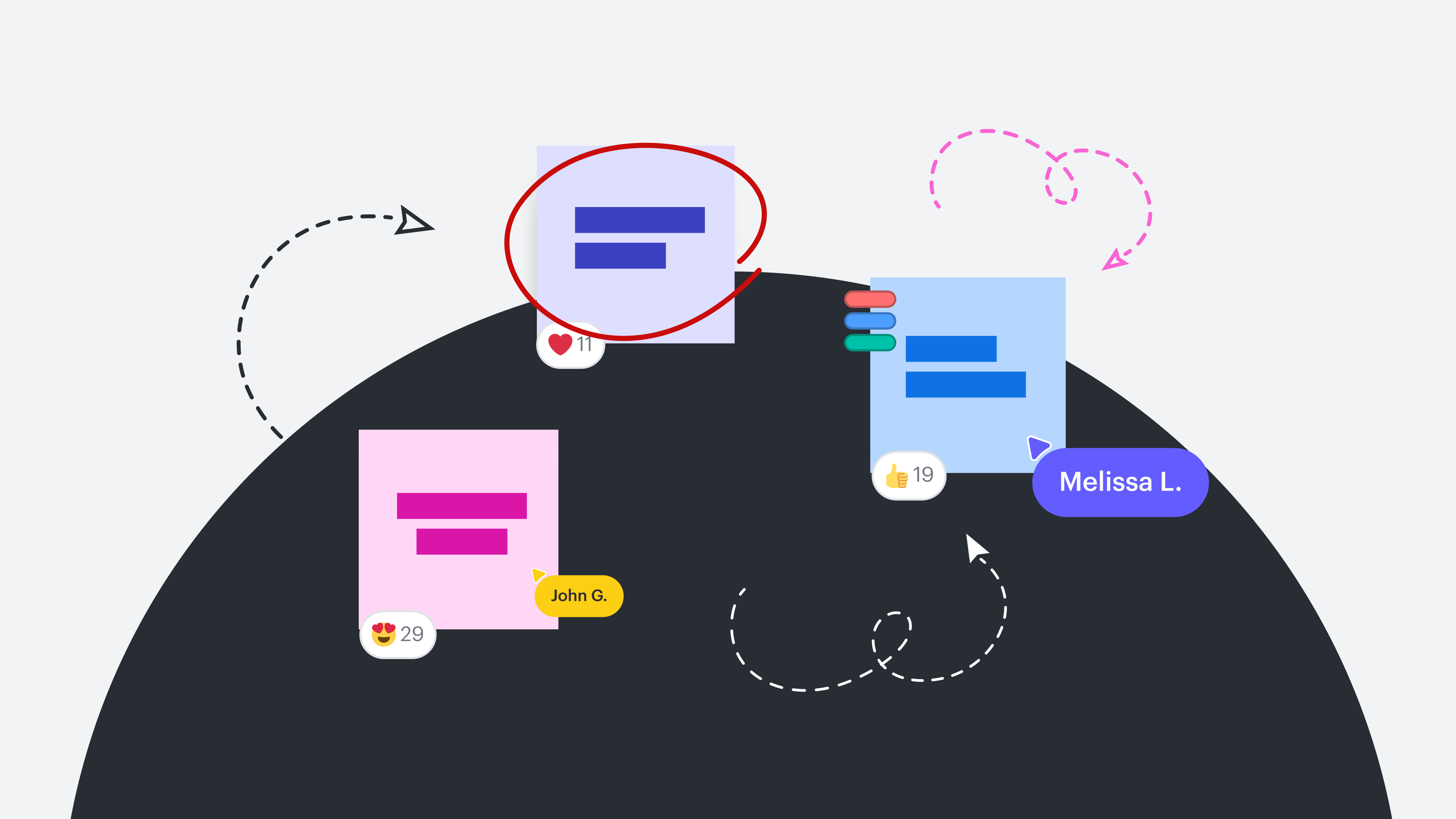
6 practical tips for more efficient collaboration
Reading time: about 7 min
Topics:
If the future of modern workplaces is hybrid, effective collaboration is the key that propels teams to success. But to many leaders, collaboration has become nothing more than a buzzword—and finding actionable ways to improve how your organization collaborates at the macro can feel like traversing through a thick fog.
It can be easy to invite more colleagues to join in on recurring meetings or adding another communication tool to your tech stack and pat yourself on the back for a “successful” collaborative initiative.
But truly effective collaboration is an individual and organizational skill set that demands strategy and creativity, and improving collaboration should be treated with the same rigor and intention of any large-scale business initiative. It’s more than just an item to check off your to-do list by holding a daily standup before everyone retreats to their silos for the rest of the day—it’s an ongoing process of growth.
In this way, effective collaboration is not merely about increased activity, but increased impact—and the result of effective collaboration should not simply be increased morale, trust and communication between teammates, but also tangible increases to your business’ bottom line and ability to innovate.
The hidden costs of inefficient collaboration
The popularization of asynchronous work has resulted in the development of many bad habits that lead to chronic ineffectiveness. These collaboration anti-patterns have created situations where teams often feel like they’re doing collaborative work, while underneath the surface, teams are actually operating inefficiently by spending effort on collaborative behaviors that aren’t driving innovation.
Why does this matter? The saying “time is money” is often disregarded as a banal platitude, but it actually applies here. Here are a few ways inefficient collaboration could be costing you both.
Inefficient collaboration is a result of poor documentation
It takes a lot to keep a team on the same page, especially when its members span locations and time zones. While it may not seem like it, keeping good documentation is actually crucial to more efficient collaboration. Without it, individuals are often forced to spend more time hunting the right information themselves rather than actually applying that knowledge in teamwork-centric settings.
For example, a recent report shared that developers typically only spend 30-40% of their time on developing features; the rest of their working time was primarily going to administrative tasks and delays. Furthermore, it found that saving just two hours weekly in an organization with 200 developers would result in an annual savings of $2.8M, roughly equivalent to the annual salaries of 10 full-time developers. With better documentation to lower the administrative load on teams, it’s not hard to imagine more of that time and money spent on critical collaborative projects.
When individuals know where to look for answers, their time can actually be spent doing what they do best. Teams who are able to master the art of documenting as they go empower members with the context needed to take ownership on projects and initiatives.
Inefficient collaboration creates unnecessary meetings
One recent survey found that on average, employees feel a third of their weekly meetings are unnecessary. These aren’t only frustrating, they’re expensive. In fact, large companies could save $2.5M annually by cutting out unnecessary meetings alone.
By refining your team’s collaborative efforts, you’ll likely reach desired meeting output faster, eliminating the need for unnecessary follow-up meetings.
Inefficient collaboration may be costing you employees
A recent Lucid report discovered that in any given meeting, 57% of attendees have a preferred collaboration style that is probably not being served. The implication that over half of your team is likely not feeling empowered to share their best ideas and thoughts is problematic—not just for their own creativity and job satisfaction, but for your business’ ability to retain them.
Another study revealed that employee turnover intent is 10x higher at workplaces that don’t foster inclusive collaboration. Losing even one employee is likely to increase L&D costs, increase the risk of further attrition, and affect your team’s innovation overall.
Practical tips for more efficient collaboration
If your business is struggling to get rid of some of these causes of ineffective and inefficient collaboration, here are some techniques you can use:
1. Regularly audit your team’s collaborative process
Conduct regular audits to evaluate your team’s collaborative efforts. You can do this formally as a part of a sprint or project retrospective, or informally as often as you need to.
Develop a handful of questions to increase the consistency and reliability of these audits. Questions should be personalized to reflect to the goals of your business, but consider a few of these recommendations:
- What percentage of attendees actively participated in the last meeting, providing comments and sharing thoughts? How does that compare to previous meetings?
- How did the last meeting move you closer to goal attainment, if at all?
- How would you describe your team’s overall productivity recently? Has it increased, decreased, or stayed the same? Why do you think that is?
- In what ways did your last meeting mitigate foreseeable project problems?
Additionally, reflect on collaboration methods as part of your audit. If you haven’t already, consider whether your team could benefit from converting a board room chat or Zoom meeting to a collaborative working session in a visual collaboration platform. These have tools and templates that provide endless opportunities for engagement and innovation (more on that in a moment).
2. Utilize pre-existing templates
When you select useful templates for your team, you create a bridge between people’s different collaboration styles so everyone feels comfortable contributing. This decreases the amount of warm-up time to get people on the same page, so everyone enters the emergent thinking zone faster.
If you’re looking for a place to start, here are some suggestions.
3. Incorporate premortem brainstorms
The more time you can invest up front anticipating difficulties, the more time savings you’ll enjoy on the opposite end of the project that can be spent on other collaborative projects. Hosting a premortem discussion allows your team to get into deep discussions on potential roadblocks and headwinds early on in a project as a way of reducing the potential for failure.
4. Get used to documenting as you go
The average adult is 323% better at understanding instructions when they include visuals. Once your team adopts a visual collaboration platform, you can codify successful ad hoc procedures and continually add to your team’s innovation repository.
When you’re using a visual collaboration canvas as your hub for all your collaborative work, you’ll never feel the post-meeting dropoff in innovation and collaboration—you’ll be able to more easily keep collaborating asynchronously with all your notes, ideation, and processes contained in a shared space.
This not only allows for quick and easy alignment across the business so information can be shared with whoever needs it, it also deepens the innovative architecture of your business so that everyone is involved in the creative process.
5. Always go in with a plan
If you leave your meeting’s agenda to chance, inefficiency will likely be its only output. Having a clear plan for a meeting ensures the important topics are prioritized, time isn’t wasted, and participation is encouraged.
Send your agenda out a few days in advance and consider including preparation items. That way, attendees can arrive ready to jump right into the collaborative process.
6. Collaborate in a visual collaboration platform
Cohesive apps are integral to your team’s effectiveness. Without them, too much time is unnecessarily spent jumping from tool to tool in order to access critical processes and sources of truth. Compiling key information in a visual collaboration suite like Lucid allows you to examine your work comprehensively through its lifespan while simultaneously integrating with the other helpful collaboration apps you’re already using.
Effective collaboration is all about interaction. Many teams struggle to involve all members in important discussions, which can make it challenging to have divergent and engaging ideation processes. Lucid’s Visual Activities are an innovative solution to this issue, lowering the barrier to entry and encouraging all team members to give their input.
It’s time to give collaboration the consideration it deserves
Effective collaboration is immeasurably more than just an individual soft skill—when done conscientiously, it will save you money and time, increase output, and decrease employee turnover.

Buyer's guide
Get the definitive guide on evaluating the right visual collaboration tools for your team.
Read nowAbout Lucid
Lucid Software is the leader in visual collaboration and work acceleration, helping teams see and build the future by turning ideas into reality. Its products include the Lucid Visual Collaboration Suite (Lucidchart and Lucidspark) and airfocus. The Lucid Visual Collaboration Suite, combined with powerful accelerators for business agility, cloud, and process transformation, empowers organizations to streamline work, foster alignment, and drive business transformation at scale. airfocus, an AI-powered product management and roadmapping platform, extends these capabilities by helping teams prioritize work, define product strategy, and align execution with business goals. The most used work acceleration platform by the Fortune 500, Lucid's solutions are trusted by more than 100 million users across enterprises worldwide, including Google, GE, and NBC Universal. Lucid partners with leaders such as Google, Atlassian, and Microsoft, and has received numerous awards for its products, growth, and workplace culture.
Related articles
Asynchronous collaboration tips from 4 organizations making it happen
Check out these experts’ proven tips for working more efficiently and effectively through asynchronous collaboration.
4 visual collaboration tips to boost team engagement and productivity
In this blog post, we’ll uncover the benefits of visual collaboration and provide tips for collaborating visually with your team.
15 hacks for making your meetings more productive with Lucid
Here are some simple hacks you can do in Lucid to save time so you can collaborate more efficiently with your team during meetings.
10+ features to use in Lucidspark for maximum collaboration
Explore our powerful features that boost your team collaboration.
